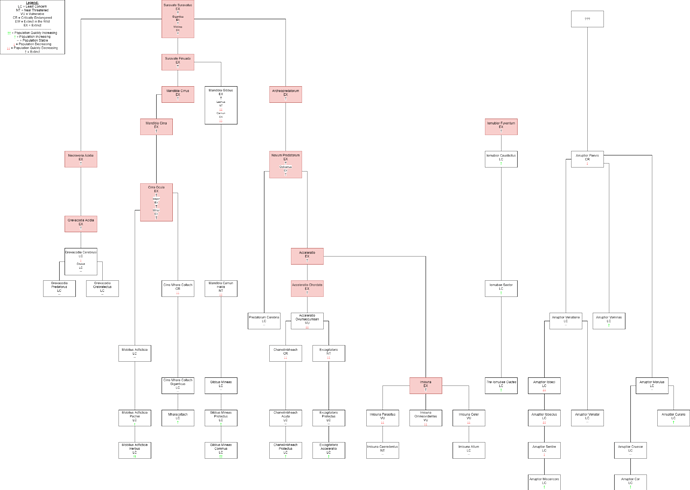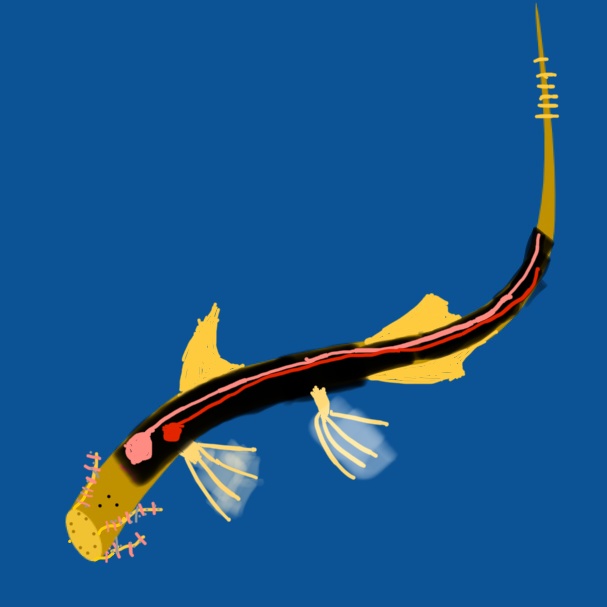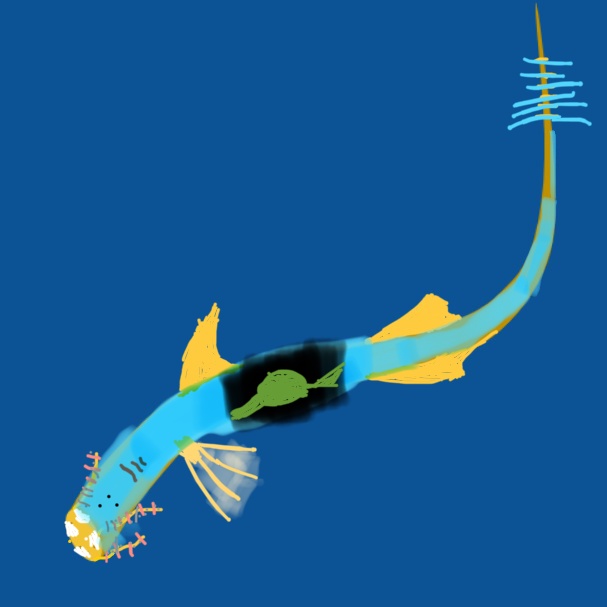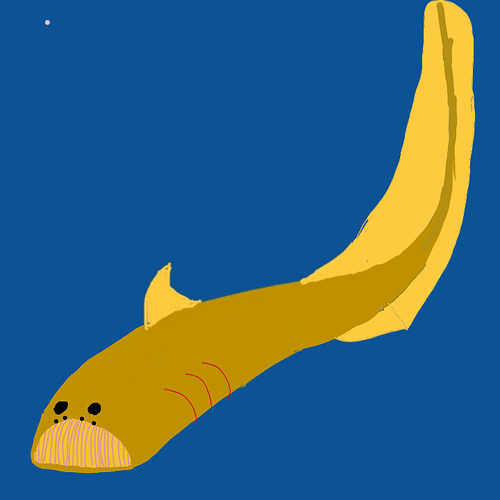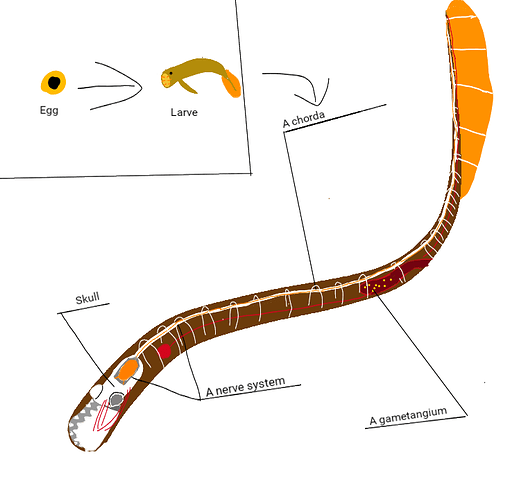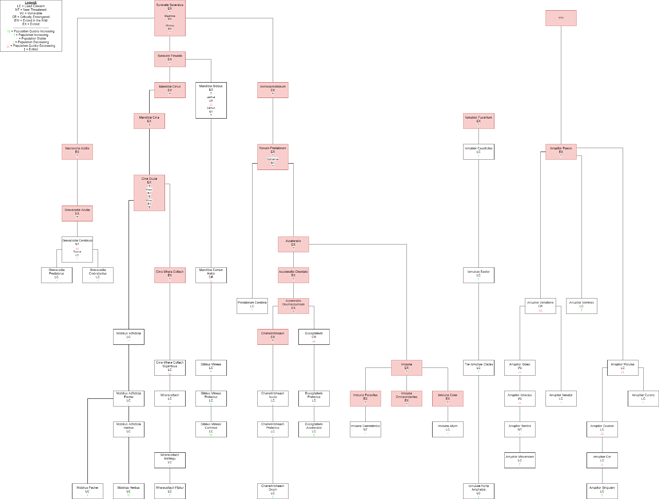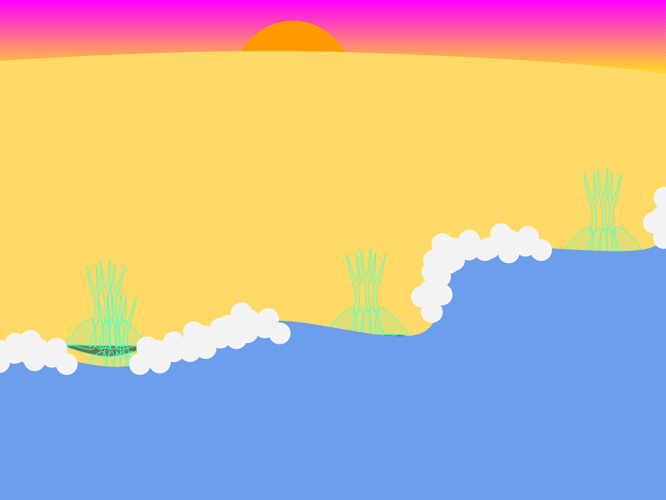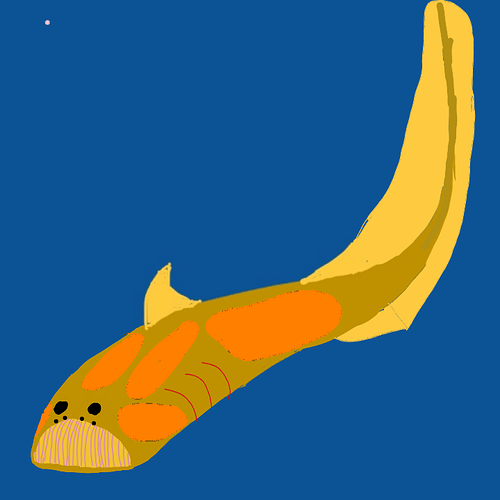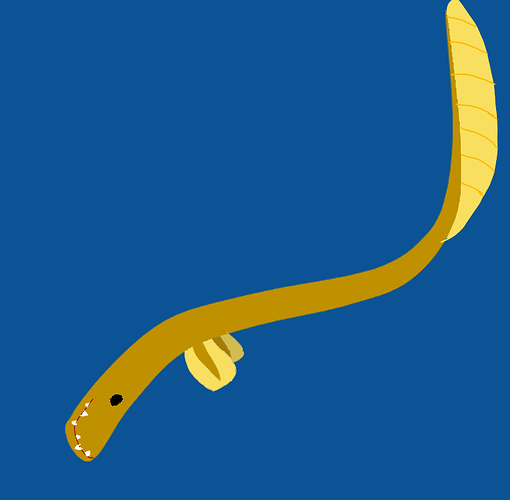Old species: Arruptor cruise||||||||||||||||||Arruptor sentire
New species: Arruptor cor|||||||||||||||||||||Arruptor misericors
Changes: Proto-heart evolves and now, it looks like bag, constantly shrinking every 1.7-2 seconds. It allows move faster and relax less.
Blood circulation cycle: Heart - Arteries next to the gills in throat, as i understood - arteries to organs - backing veins, converging in near-spine vein - Heart. Heart has only 1 camera - ventricle, contracts thanks to the special muscles.
Changes in behavior: Less stops to relax, faster reaction.
I did a scheme. I hope, you’ll understand all
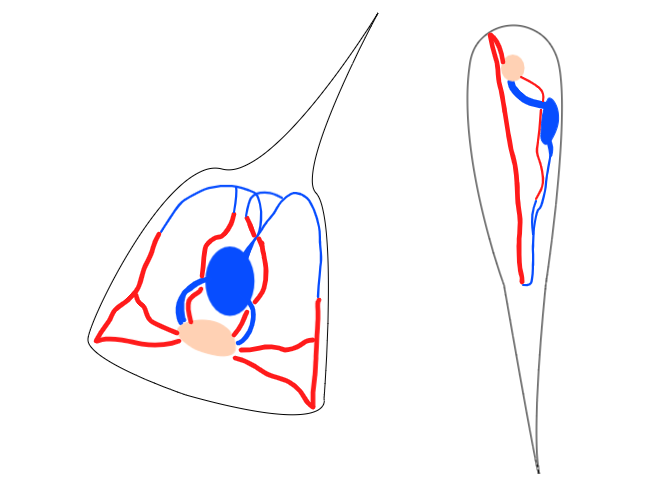
Pale ellipse - zone near the gills, blue ellipse - heart with venous blood, blue and red lines - vessels with venous and arterial blood respectively
I won’t be able to use discoed for about a week because i am going on a trip with family for spring break. Is it fine if I just post here for that time?
Again, break today. Have three tests tmw lmao, but discord server is almost ready to get going! Also, Oofer, that’s totally fine with me! I’m going to post the updates on the forums anyways.
Finally, we’re back. The Arruptiors have gained a more centralized circulatory system in two branches, both very similar to one another. The Cruesor has branched off into the Cor, and the Sentire has branched off into the Misericors. The original Arruptiors are dying out, and meanwhile, the Surav worms continue to spread across the globe.
https://discord.gg/XfYZeDt this is the discord server link! I will set up roles and such very soon. Short posts will become less and less common, as I am planning things, and am open to suggestions!
New species: Mobilius Pachei
Old species: Mobilius Adfictia Pachei
Changes: Pachei has evolved a second rotary fin farther back than the first one. This fin is pointed backwards for propulsion and is slightly less flexible.
Behavior: Nothing new
New Species: Mobilius Herbus
Old Species: Mobilius Adfictia Herbus
Changes: Herbus has evolved a stomach to further digest it’s food.
Behavior: Nothing new
New Species: Gibbus Mineas Commus
Old Species: Gibbus Mineas Commus
Changes: Workers are now larger and their legs have become more powerful.
Behavior: workers go out in groups and bring back entire corpses.
No visual changes
New species: mharacoltach fljótur
Old species: mharacoltach meltingu
Changes: fljótur has evolved a more a more fast and agile back tail and also has evolved into more bigger size (30cm)
New species: chaneilinbheach ovum
Old species: chaneilinbheach protectus
Changes: ovum has evolved appendiges at the back of tail so they wrap around themself when mating.
New species : excogitatoris accelerato
Old species: excogitatoris accelerato
Changes : excogitatoris has evolved a fully mineralised skeleton and also has exploded in size (5cm). And also some sort of primitive ribs
Back to Kakhitt. Ah, the good old days when there were no Surav worms, just microorganisms floating around near the vents. Species have branched off, and the Commus have grown their armies bigger and bigger. Some predators have begun to feed on them now, taking the workers away from the hives to eat. The Fljótur has become much much bigger, becoming a foot long! Now it’s easier for the Arruptiors to see, but since they’re harder to digest (no teeth) they don’t get eaten as often. The Excogitatoris has also become much bigger, and their colonies are becoming larger as well. Perhaps the Commus and the Accelerato will fight? No reason to believe so, as they live in different places in the ocean. However, a new frontier has been discovered.
A beautiful sunset on the planet of Kakhitt, devoid of life on land, but not under the water. Soon to change. The Iomubae Horta was one of the many smaller plants that lived in the shallows, using both it’s fork-like feeders and the pigments inside to capture energy through the forms of molecules and sunlight respectively. Some of them, the ones with more pigmentation than fork-tentacles, pushed to the surface. There, they began to change, gaining a less porous membrane (still transparent, though) and allowing their underside thallus to absorb water in it’s stead. These are the first colonizers of land, and there are many ways for them to spread. But more will come soon.
The Iomubae Horta Amphabis is a evolvable species. Also, another change. Instead of a historical cladogram, I am switching my system to a food-web. As the world continues, the biomes will be made by the players as well as me. This will allow for some interesting niches, and these niches will be competed for by the animals that first appear on land. The race is on!
So, because I have time now, can I join?
Of course, we will don’t mind. If you want, join.
As Gotor said, you can join anytime! Just be sure to join the discord as well, if you have one
New species: Mobilius Pachei
Old species: Mobilius Pachei
Changes: Pachei’s fins have become stronger, allowing it to “crawl” on the ocean floor stalking its prey. no visual changes.
Behavior: Nothing new
New Species: Mobilius Herbus
Old Species: Mobilius Herbus
Changes: Herbus’s stomach has become stronger, due to the fact that it supports an extremely large amount of bacteria in its stomach.
Behavior: Nothing new
Not posting an update of the species map today, instead you guys get this!
On Evolution in Kakhitt
Physical Evolutions
Appendages
- Appendages are classified as protrusions on the body of a creature that has a function, however limited it may be. Appendages can be changed (split , duplicated), removed off of the creature, moved from the site, or a combination of these two. However, an appendage cannot be added EXCEPT if a similar appendage exists on the organism already. For example of what you cannot do, you cannot add a fin if no fin already exists on the organism. You can, however, take a finger and split it into 5 parts, then say that a mutation occurs making a film between the splits, making a fin. When you are adding an appendage to an organism, please state exactly which appendage it came from, where these appendages came from, and if any changes occurred to it.
Organs
- Organs are specialized parts of an organisms body that have mostly metabolic functions, such as the stomach or the liver. Organs are not restricted to the same rules as appendages, but there are limits. Organs need energy to function, which means that if I deem an organ to cost too much energy, it will have to grow smaller or be scrapped. However, I am pretty lenient on organs, and if you have any questions about them, come to me.
Skeletons
- Skeletons are a very important part of the body of many organisms, whether exoskeletons or endoskeletons. They provide structure and support to many organisms, and so I will be lenient about them as well. However, remember that if a skeleton gets too hard for the organism to manage (ex, too heavy) these organisms will quickly die out.
Appearances
- Appearances, such as pigments and the like, are used for attracting and repelling. When an organism evolves a new appearance, please describe why the appearance is there (ex, mating purposes, scaring away predators, attracting prey) and how the organism uses the appearance for it’s purpose.
Mental Evolutions
- This will be a smaller chunk, but it will still be filled with information. Mental evolution only occurs if a creatures current brain is not up to the task, such as if they live in a very difficult environment and need to find food that is good at hiding, or some other harsh area. If they have a need for a bigger brain size, then I will allow an evolution like that to occur. Please describe what changes in the brain, and why it does. Sapience will be very uncommon, but if a species has enough challenges, then they will gain it in bits and pieces. Once a real tribe actually forms, the third stage of this game will begin. Let’s hope we get that far, although I don’t doubt it.
New species: mharacoltach fljótur
Old species: mharacoltach fljótur
Changes: mharacoltach fljótur has evolved a hard skin in sone places for defense
New species : chaneilinbheach ovum
Old species: chaneilinbheach ovum
Changes: ovum has evolved into bigger size (5cm)
(No visual changes)
New species: excogitatoris accelerato
Old species: excogitatoris accelerato
Changes: acceleratio has evoled fins. They evolved from the Larvae appendages, beacause of lack of testosterone. And also some size (10cm)
Where did the fins of the Accelerato come from? Please describe how they evolved as stated by my post above.
Good? (Somebody onca…)
It’s better, but they don’t look like the appendages on the larvae. Please state how the fleshy appendage kept on the excogitatoris evolved into the fins they have now.
New species: excogitatoris microterra
Old species: excogitatoris accelerato
Changes: microterra has shrunk, and breathes through its skin. It also retains fleshy limbs from its larval form.
Welcome BurgeonBlas! Many species will rise by your hand. Unfortunately, you can’t evolve from Thunder’s excogitatoris, because of the fact that I haven’t approved and posted the new tree, along with the fact that the air doesn’t have nearly enough oxygen for any organism, apart from the Horta Amphabis and any evolutionary descendants.
Excogitatoris accelerato is on the last tree you posted
At that point, the Excogitatoris had not evolved it’s fleshy fins, which is why Thunder is doing it now. To facilitate conversation, if you can join the discord it would be helpful. https://discord.gg/XfYZeDt
